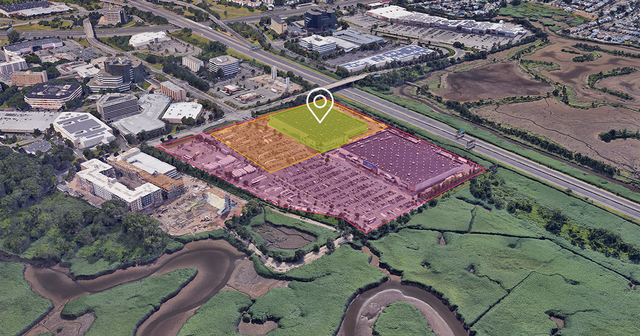Picture this: you can show your favorite digital ads to your target audience based on their precise geographic locations. From shopping centers to food establishments, your digital ads will appear before the eyes of local and potential customers. Even your competitors’ home turf would not be safe from your freshest digital-based campaign! It sounds like a marketer’s dream, right? Well, thanks to the magic of geotargeting, this dream is now a reality!
This guide will explain what geotargeting is and how to geotarget to get more attention from your audience. It shares information on the effectiveness of geotargeting, as well as geotargeting marketing examples you can use for inspiration.
Ready for your next advertising campaign to hone in on your target market? Let’s start with the definition of geotargeting.
What is Geotargeting?
Geotargeting (also called geotargeted advertising) is a type of advertising that uses location data to reach consumers with messaging appropriate to their locality and behavior. This technology displays content based on an automated or assumed knowledge of consumers’ location.
Let’s say you run a quick service restaurant. When consumers opt-in to location services for your QSR app on their phones, geotargeting advertising lets you show ads based on their actual location. So, the next time your target consumers are close to the restaurant, you can show digital ads to them and encourage them to visit.
Here’s another example. A car repair shop or auto dealership might run a geotargeting advertising campaign to show a certain ad to people who are within 10 miles of the shop’s location. Geotargeting advertising is even more specific. When consumers opt-in to location services for apps on their phones (such as a retail or restaurant app), geotargeting advertising lets you show ads based on their actual location. For example, if you run a quick service restaurant or clothing store, you can show ads to target consumers who are close to the premises and encourage them to visit.
In a nutshell, geotargeting helps advertisers create more relevant, targeted promotions for consumers, resulting in increased engagement.
How Does Geotargeting Work?
Wondering how geotargeting software works? First, it detects users’ locations. This is either specific, using GPS, or slightly broader, using cell towers. Second, the software or app uses this information to decide what information to show those users. There are two main ways to geotarget consumers:
Geotargeting App
The first, mentioned earlier, is via a geotargeting app. This is any app that uses location-based marketing. For example, when you sign into a food delivery app, you’ll see options that are close to your location. And when you search for “dentists near me” in your maps app, the results are an example of geotargeting in action.
Geotargeting Software
You can also use geotargeting software to better reach your target audience. For example, GroundTruth offers geotargeting advertising services, which include three important targeting tools. These are audience targeting, location targeting, and weather targeting.
Audience Targeting
GroundTruth’s audience targeting technology helps you to:
- Target ads to people who have visited a category, brand, or location within a certain time period.
- Use behavioral targeting by including data on both demographics and visitation.
- Create custom audiences by including data on consumer shopping habits and other behaviors.
Location Targeting
Geotargeting advertising also relies on location targeting. This gives additional insight into how customers behave in particular localities. Here’s what’s included in GroundTruth’s location targeting service:
- On-premise mobile location targeting: A geomarketing tool that lets you know where your customers are. This tool can adapt your geotargeting advertising campaigns depending on whether your audience is nearby, in the parking lot, or in your store.
- Proximity targeting: A geofencing technology where you show promotions to people near your target location.
- Neighborhood targeting: Ad technology that relies on demographic and visitation behavior within an area to show the right promotions.
Weather Targeting
Weather affects customer behavior – you don’t buy umbrellas when it’s sunny out, do you? This insight is exactly how weather targeting can enhance your next ad campaign! Use GroundTruth’s weather targeting to show promotions that match the audience, the location, AND the prevailing conditions. You can use audience targeting, location targeting, and weather targeting to run many types of geotargeting advertising promotions. GroundTruth’s data shows that in-app ads are particularly effective, but you can also use mobile push notifications, SMS messages, and display ads on digital billboards.
Geofencing Vs Geotargeting
We get it – it’s pretty easy to mix up geofencing and geotargeting. Both are location-based marketing techniques that deliver ads to customers, but there is a fundamental difference between the two. Geofencing creates a virtual boundary around a specific location, allowing marketers to target consumer devices within that set boundary with ads, offers, and so on. Geotargeting, on the other hand, delivers ads based on their target market’s geographic location, identifying their specific locations through IP addresses, GPS coordinates, and proximity marketing.
Is Geotargeting Marketing Effective?
There are several reasons why incorporating geotargeting into your marketing strategy makes sense. First, the potential audience is huge. In the US alone, 81% of people own a smartphone, and the percentage is even higher for young consumers. Among millennials, nearly all (94%) possess a smartphone and allocate more of their leisure time to using these devices instead of watching TV. Research from MarTech Series reveals that 83% of marketers find their campaigns are more successful when they use location data. In addition:
- Geotargeting technology can help marketers win more business and improve customer relationships. Because it’s based on customer behavior, marketers can understand and meet their customers’ needs, resulting in greater campaign engagement.
- Geotargeting is particularly effective for increasing online traffic and foot traffic.
- Using location data is proven to make marketing campaigns 80% more effective. If you know where potential customers hang out, it’s easy to show them the right promotions at the right time.
Geotargeting Examples
Wondering how to use geotargeting in your upcoming strategy? Check out a few successful client examples of geotargeting taking marketing campaigns to the next level:
- Ulta Beauty used geotargeting to boost the effectiveness of new store openings. The beauty retailer leveraged location and behavioral insights to reach potential customers who were near competitor shops and would be most interested in learning about new stores. Stores supported with GroundTruth’s location insights outperformed the others, reaching their weekly visitation targets 43% faster than other stores.
- Toyota leveraged GroundTruth’s neighborhood and location data to identify audiences most likely to shop for a new car and to encourage them to visit nearby auto dealerships. The campaign resulted in 1,200 visits to specific dealerships and additional visits to smaller dealerships not targeted in the geotargeting advertising efforts.
- Warrior Sports used visit optimization and behavioral audience targeting to allocate its media budget to tactics that drove visitation rates. Through reaching and engaging an untapped audience of fitness enthusiasts, the month-long campaign earned 33% more visits to specific retail locations than the previous campaign approach.
Conclusion
As our 101 guide shows, geotargeting can be an absolute game-changer in an advertising campaign. Through leveraging location-based ad technology, you can reach the right audience at the perfect location, earning your business higher awareness and profits. Now that you know what geotargeting advertising is, the benefits of geotargeting, and the technology behind it, it’s time to set your sights on how to incorporate it into your marketing plans! Aim for the stars, marketers!
Think geotargeting is right for your campaign? Learn more about how GroundTruth’s self-serve advertising platform can help you build your geotargeting strategy.





